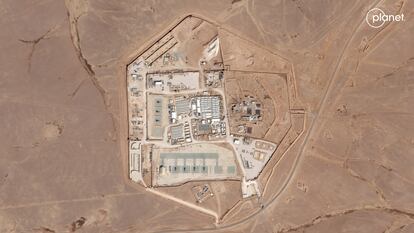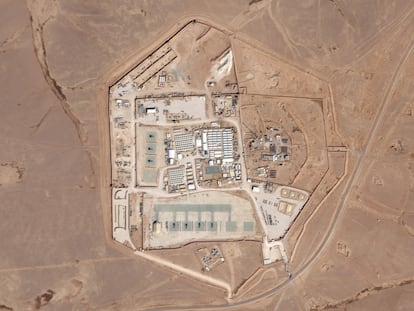US bolsters defenses around Jordan base as it readies strikes in response to drone attack
One of Iraq’s strongest Iran-backed militias, Harakat al-Nujaba, announced its plans to continue military operations against U.S. troops, despite other allied factions having called off their attacks

The U.S. has bolstered defenses at a base in Jordan that was attacked by Iran-backed militants as it prepares for a wider U.S. response to a drone attack that killed three service members, a U.S. official said Friday.
Even as a larger U.S. military response seemed imminent, some Iran-backed factions pledged to continue to attack U.S. forces in the region. In a statement released Friday, one of Iraq’s strongest Iran-backed militias, Harakat al-Nujaba, announced its plans to continue military operations against U.S. troops, despite other allied factions having called off their attacks in the wake of a Sunday drone strike in Jordan.
The U.S. response against threats by Iran-backed Houthis in Yemen, who have been firing drones and missiles at commercial and military ships in the Red Sea, continued Friday as well. A second U.S. official confirmed the military had taken self-defense strikes inside Yemen against Houthi military targets deemed an imminent threat.
Al-Masirah, a Houthi-run satellite news channel, said that British and American forces conducted three strikes in the northern Yemeni province of Hajjah on Friday. The strikes targeted the al-Jar area, the news channel said in a short post on its Telegram page. Hajjah province is situated northwest of the capital, Sanaa, and is a Houthi stronghold.
While previous U.S. responses in Iraq and Syria have been more limited, the attack on Tower 22, as the Jordan outpost is known, and the deaths of the three service members has crossed a line, the official said. In response, the U.S. is weighing a much wider response to include striking militia leaders. The U.S. options under consideration include targets in Syria, Yemen and Iraq, where the Iranian-made drone that killed the service members was fired from, the official said.
The attack on Tower 22 led to the first deaths of U.S. service members since the war between Israel and Hamas broke out. U.S. response options were being weighed as President Joe Biden, Defense Secretary Lloyd Austin and Chairman of the Joint Chiefs Gen. CQ Brown traveled to Dover Air Force Base in Delaware to be with the families of those fallen soldiers as they are honored at a transfer ceremony.
The U.S. has blamed the Jordan attack on the Islamic Resistance in Iraq, a coalition of Iranian-backed militias. In the days since the attack, the U.S. has bolstered the defenses around Tower 22, which houses about 350 U.S. troops and sits near the demilitarized zone on the border between Jordan and Syria. The Iraqi border is only 6 miles (10 kilometers) away.
On Thursday Defense Secretary Austin indicated that the U.S. response against the militias would widen. “At this point, it’s time to take away even more capability than we’ve taken in the past,” Austin said in his first press conference since he was hospitalized on Jan. 1 due to complications from prostate cancer treatment.
Austin said that Iran has had a hand in the attacks by supplying and training the militias. The U.S. has tried to communicate through backchannels to Iran over the last few months to get them to rein in the militant groups, another U.S. official said.
The officials spoke on the condition of anonymity to discuss details that have not been acknowledged publicly.
The U.S. has also tried more limited military responses in a series of strikes against weapons storage sites and training areas. So far, the U.S. response has not deterred the groups, which have attacked U.S. facilities at least 166 times since October.
At least one group, Kataib Hezbollah, another powerful Iranian-backed Iraqi militia, which has been watched closely by U.S. officials, said Tuesday it would “suspend military and security operations against the occupying forces” to avoid embarrassing the Iraqi government in the wake of the Jordan attack.
Sign up for our weekly newsletter to get more English-language news coverage from EL PAÍS USA Edition
Tu suscripción se está usando en otro dispositivo
¿Quieres añadir otro usuario a tu suscripción?
Si continúas leyendo en este dispositivo, no se podrá leer en el otro.
FlechaTu suscripción se está usando en otro dispositivo y solo puedes acceder a EL PAÍS desde un dispositivo a la vez.
Si quieres compartir tu cuenta, cambia tu suscripción a la modalidad Premium, así podrás añadir otro usuario. Cada uno accederá con su propia cuenta de email, lo que os permitirá personalizar vuestra experiencia en EL PAÍS.
¿Tienes una suscripción de empresa? Accede aquí para contratar más cuentas.
En el caso de no saber quién está usando tu cuenta, te recomendamos cambiar tu contraseña aquí.
Si decides continuar compartiendo tu cuenta, este mensaje se mostrará en tu dispositivo y en el de la otra persona que está usando tu cuenta de forma indefinida, afectando a tu experiencia de lectura. Puedes consultar aquí los términos y condiciones de la suscripción digital.
More information
Archived In
Últimas noticias
Most viewed
- Reinhard Genzel, Nobel laureate in physics: ‘One-minute videos will never give you the truth’
- Oona Chaplin: ‘I told James Cameron that I was living in a treehouse and starting a permaculture project with a friend’
- Pablo Escobar’s hippos: A serious environmental problem, 40 years on
- Why we lost the habit of sleeping in two segments and how that changed our sense of time
- Charles Dubouloz, mountaineering star, retires at 36 with a farewell tour inspired by Walter Bonatti










































